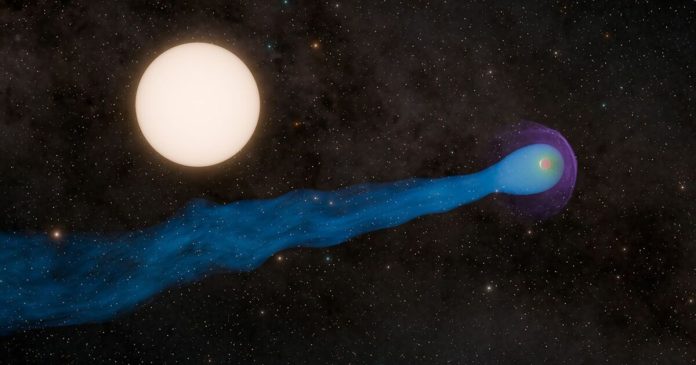Astronomers have recently made a fascinating discovery of an exoplanet with a tail, resembling a massive comet. This exoplanet, named WASP-69b, is gradually evaporating due to the intense radiation from its host star.
WASP-69b is a gas giant orbiting very close to its host star, categorized as a Hot Jupiter due to its proximity. While Hot Jupiters are common among exoplanets, WASP-69b stands out with its luxurious tail, giving it the appearance of a comet. The star’s radiation, known as the stellar wind, not only erodes the planet’s atmosphere but also forms a long tail similar to that of a comet.
In a recent study utilizing the KECK Observatory in Hawaii, astronomers observed WASP-69b in detail, unveiling its tail that extends approximately 580,000 km (360,000 miles), equivalent to one and a half times the distance from Earth to the Moon.
Lead author of the study, Dakotah Tyler, mentioned, “Previous research hinted at the planet losing its atmosphere, possibly having a subtle tail or none at all. However, our findings definitively confirm the presence of this tail, which is at least seven times longer than the planet itself.”
Although the astronomers were unable to observe the tail’s complete extent due to time constraints, they believe it continues to change over time in response to fluctuations in the stellar wind.
WASP-69b is losing gas, predominantly hydrogen and helium, at a rate of about 200,000 tons per second. Despite this seemingly rapid loss, it equates to only one Earth’s mass every billion years. Over its estimated lifespan, the planet has shed about two Earth’s worth of gas, indicating a substantial reservoir remaining.
Tyler added, “With a mass approximately 90 times that of Earth, WASP-69b possesses a vast reservoir of material. Even with the substantial gas loss, the planet is not at risk of losing its entire atmosphere during the star’s lifespan.”
The detailed findings were published in The Astrophysical Journal. Watch the video below to see an animation of WASP-69b’s tail.
WASP 69b 2K




